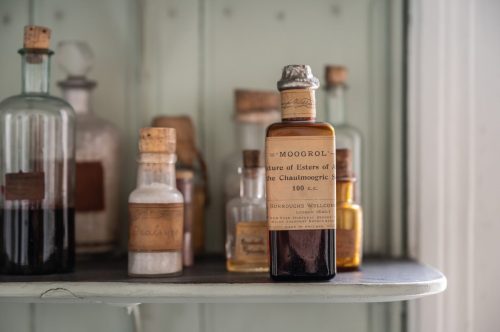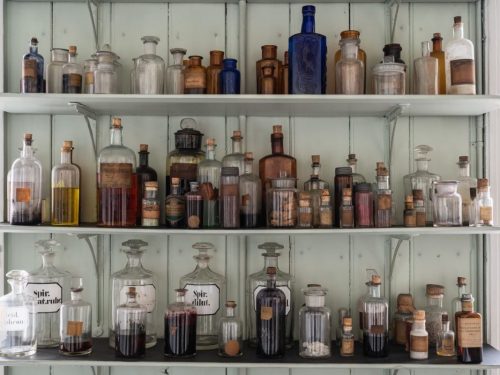Chaulmoogra oil used at Pleiestiftelsen Hospital

This oil was extracted from the seeds of the fruit of the Chaulmoogra tree in India, and it was used in the East for hundreds of years, not least to treat various skin disorders. The oil came to Europe in the mid-19th century, and several doctors claimed that it seemed to have a positive effect on leprosy patients. The oil was used and applied in ever new ways, both externally and internally, but it had many side effects and the results varied.
A young female chemist at the University of Hawaii, Augusta Ball, developed a method to make the active component of the oil water-soluble so that it could be injected directly into the muscle. The new product greatly improved the health of many people both in Hawaii and in other countries, becoming the most common treatment for leprosy in the world in the 1920s and 1930s.
However, it was not the miraculous cure for the disease that many people hoped, although it was the most effective treatment available before sulfa medications and, later, MDT came on the market. Unfortunately, Alice Ball died in 1916 at the tender age of 24 , and did not live to see the impact of her work, or any of her work published. The work of isolating individual constituents of the oil was taken over by Dr. Arthur Dean, and the medication was often subsequently referred to as ‘Dean’s derivatives’.

Photo: Bergen City Museum. Objects belong to the Bergen Collections on the History of Medicine.
Danielssen mentioned Chaulmoogra in Lungegaard Hospital’s annual report as early as in 1865. He noted that Rudolf Virchow had received the oil from a doctor in Bengal in India, and that he was keen to try it, although he did not have much faith in its ‘healing power’. Nor did his own trials a few years later generate any positive results.
Around 1900, H. P. Lie stated that he had tried both Chaulmoogra ointment and pills. He also intended to try injections under the skin, but refrained from this, since none of the residents at Pleiestiftelsen Hospital were willing to try it and he knew that such injections could be ‘accompanied by nasty complications’. He was afraid that he would not be able to continue with ‘any cure attempts’ if any kind of incident frightened the patients.
However, one patient record shows that one female resident had repeatedly expressed a desire to try Dean’s derivatives, and that she received numerous injections into her muscles in March and April 1924. We do not know whether this led to any improvement in her condition. She died in 1928, a few days before her 74th birthday.

Bergen City Archives.



